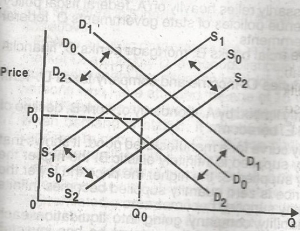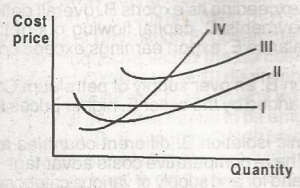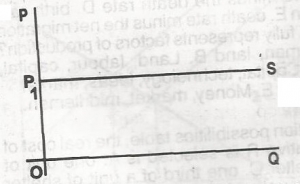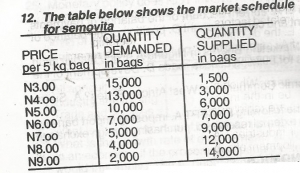Which of the following are direct taxes?
- A. Sales taxes
- B. Excise taxes
- C. Income and company taxes
- D. Tarrif duties
- E. Commodity taxes

The curves Do Do and SoSo are the demand and supply curves respectively. What happens when government subsidizes producers in order to boost output?
- A. The supply curve will shift from SoSo to S2S2
- B. The supply curve will shift from SoSo to S1S1
- C. The supply curve will shift fromS 2S2 to S1S1
- D. The supply curve will shift from S1S1 to SoSo
- E. The demand curve will shift from DoDo to D1D1

In perfect competition a firm’s price is equal to its marginal revenue which is again equal to average revenue. This form maximizes its profits when its marginal cost (MC) is equal to price (p). Which of the curves in the diagram below represents the firm’s marginal cost (MC)?
- A. Curve I
- B. Curve ll
- C. Curve lll
- D. Curve lV
- E. Curves l and lll

In the diagram P1 S is a supply curve for a manufactured. it is shows that
- A. when price is OP1 quantity supplied is infinitely elastic
- B. the higher the price the greater the quantity supplied
- C. the higher the price the lower the quantity supplied
- D. when price is zero quantity supplied becomes infinite
- E. when price is infinite quantity supplied becomes zero

What is the market equilibrium price?
- A. 5.00
- B. 8.00
- C. 9.00
- D. 7.00
- E. 6.00
Nigeria is currently implementing the?
- A. third development plan
- B. second development plan
- C. fourth development plan
- D. fifth development plan
Differentiated product is the characteristic feature of?
- A. perfect competition
- B. pure competition
- C. monopolistic competition
- D. monopoly
- E. oligopoly
Demand for a factor of production is?
- A. a composite demand
- B. a joint demand
- C. a derived demand
- D. an elastic demand
- E. cross-elasticity of demand
Full employment is a situation in which?
- A. every adult is employed
- B. all adults who can work are employed
- C. all person who attained the age of 15 and above are employed
- D. only the disabled are not employed
- E. all those who are able and eligible can find employment
When demand is elastic, it means that consumers
- A. react more proportionately to price change
- B. are not sensitive to price changed
- C. will stop buying when price increases
- D. react less proportionately to price change
- E. react equally to price change
NEPA as a public corporation is?
- A. a power generating industry in Nigeria
- B. organized in a perfect competitive market
- C. a duopoly
- D. a monopolistically competitive industry
- E. a monopoly
Age-structure in Nigeria is such that the working age-group is in the years
- A. 1-15
- B. 15-65
- C. 30-40
- D. 40-65
- E. 65 and above
Which of the following defines Economics most comprehensively?
- A. Buying and selling
- B. Organization and Industries
- C. study of human behaviour in the allocation of scarce resources
- D. National development planning and budgeting
- E. Banking and Insurance
Agriculture plays a dominant role in West Africa economics because
- A. the green Revolution in Nigeria is agriculture
- B. it supplies all the foodstuff consumed in West Africa
- C. there are large plantation of cocoa, groundnut and palm oil in West Africa
- D. it is the main source of revenue in Nigeria
- E. it employs more than 50% of the total labour force in West Africa
Money performs a number of functions, ONE of these functions makes is possible for any person to provide for old age?
- A. money is regarded as a medium of exchange
- B. measure for value
- C. unit of account
- D. store of value
- E. standard for deferred payments
The effect of emigration on a country’s population, all other things remaining equal, is to
- A. increase its size
- B. cause overpopulation
- C. increase its growth rate
- D. reduce the proportion of children
- E. reduce its size
The monetary system that requires double coincidence of want is known as?
- A. the gold standard
- B. barter
- C. the commodity system
- D. the gold exchange standard
- E. the cheque system
Which of the following is NOT an advantage of localization of industries?
- A. Reaping of external economies
- B. Development of a pool or skilled labour for industry
- C. Development of subsidiary industries
- D. Development of organized markets
- E. Growth of conurbations
When a government owns enterprises, a number of advantage arise. Which of the following is NOT one of such advantages?
- A. More capital is provided
- B. Price policy may be the interest of consumers
- C. Government workers may be indifferents towards the public
- D. Infrasturcture are rapidly developed
- E. income may be more evenly distributed
A major function of middlemen in Nigeria is the distribution of?
- A. commodities to all consumers regardless of income
- B. commodities to consuming centres and the collection of money income to producing centres
- C. economic welfare to all
- D. wealth to all
- E. poverty within the society
If any economy is growing at an annual rate of 7% and 4% of it is known to be due to the improvements in labour and capital combined, the balance of 3% is usually due to?
- A. land and related factors
- B. abundance of natural resources
- C. level of human capital
- D. technical progress or other factors
- E. the discipline of political leadership


